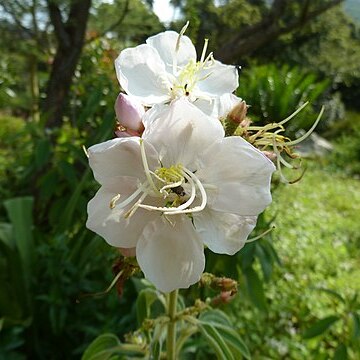Leaves 2–3(4)-nate, frequently reflexed, petiolate; lamina 3–14·5 x 1–5·5 cm., lanceolate to ovate-lanceolate, roundish to subcordate (sometimes cordate) at the base, acute at the apex, crenulate at the margin, ± dark or light green above, pale green, whitish or yellowish below, subappressed-setose on both faces but more densely so beneath (the bristles ± long, simple or divided from the base), longitudinally 5–7-nerved, the longitudinal nerves impressed on the upper face, prominent on the lower one, the transverse ones numerous, 1 mm. distant, usually inconspicuous above, ± raised beneath like the reticulation; petiole 0·5–4 cm. long, scaly-setose.
An evergreen shrub. It grows 2.5 m high and spreads 2 m wide. The stem is erect and slender. It is hairy. The leaves are green and opposite. They are sword shaped and have parallel veins. The flowers are a blue to purple colour. They have 5 petals. They are in clusters at the ends of the branches. There are two varieties.
Flowers 5-merous, subsessile in dense cymes, arranged in short terminal very compact inflorescences or in racemiform or pyramidal panicles up to 23 x 16 cm.; bracts shorter than the receptacle, broad-ovate, obtuse or acute, purple and appressed-setulose outside, caducous.
Fructiferous receptacle 8–12 x 6–8·5 mm., scarcely to somewhat contracted above the capsule. Capsule shorter than the receptacle, broadly ovoid to spherical, appressed-setose at the apex and with a crown of long bristles surrounding the insertion of the style.
Sepals 7–10 x 2·5–3·5 mm., oblong, oblique-truncate or acute and setose or with a setose appendage at the apex, ciliate at the margin, purplish, dorsally hairy, caducous; intersepalar segments rectangular or linear, ± long-bristly at the top.
Receptacle 6–10 x 5–6 mm., covered by numerous ± long flat appendages pilose all around, tipped by several ± long ascending white or yellowish-white bristles.
Old branches subcylindric and striate, the younger ones angular, ± scabrous or setose with small branched scale-like bristles.
Longer stamens: anthers 9–12 mm. long; pedoconnective 15–20 mm. long, with the basal appendage c. 1·5 mm. long.
Shorter stamens: anthers 8–10 mm. long; pedoconnective c. 3 mm. long with the appendage shorter than above.
Petals c. 2·5 x 2 cm., lilac to dark purple or violet, rarely white.
A perennial herb or a much-branched shrub up to 3(4) m. tall.
